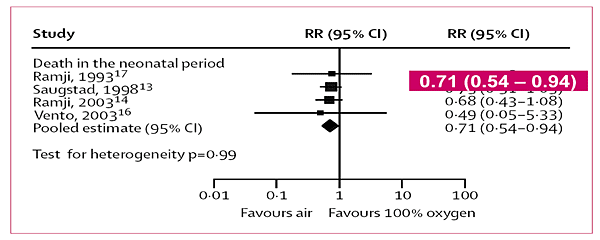The potential adverse effects of 100% oxygen during newborn resuscitation are well described in the neonatal and animal resuscitation literature. Meta-analysis of randomized controlled trials of resuscitation of human infants with air (21% oxygen) versus 100% oxygen have shown a significant reduction in mortality and no evidence of harm when air is used (Davis, et al., 2004).
Table 1 shows the pooled results of 1297 term and preterm infants who were randomized to receive air (21% oxygen) or 100% oxygen for resuscitation, with the primary outcome being death in the neonatal period. The pooled results favored resuscitation with air.

Table 1: Pooled analysis. Reference: Davis, Tan, O ’Donnell & Schulze, 2004, p. 1332
The additional following effects were reported in the meta- analysis when 100% oxygen was used for resuscitation in term infants:
- Delayed the time to first breath
- Delayed the time to first cry
- Caused oxidative stress for up to 4 weeks (Davis, et al., 2004)
Vento, et al., (2005) demonstrated that the use of room air for resuscitation of asphyxiated term newborns caused less oxidative stress and diminished ischaemic reperfusion derived acute damage to the myocardium and kidney as compared to 100% oxygen.
What is oxidative stress?
Small amounts of free radicals are generated continuously in living organisms and are necessary for normal cell reactions and cell growth. A free radical is an atom or molecule that contains one or more unpaired electrons. Free radicals are highly reactive and can donate or attempt to remove electrons from other molecules. Once they have paired up with a captured electron, a cascade mechanism is triggered, resulting in disruption to the living cell and damage to proteins, DNA and lipids. The free radicals of interest are the ones derived from oxygen: so called reactive oxygen species (ROS).
Oxidative stress may be considered as an imbalance between pro and antioxidant forces or between the amount of reactive oxygen species and antioxidant defenses.
The transition to extrauterine life causes oxidative stress which is beneficial to the newborn because it contributes to the activation of a number of metabolic pathways. Normally, reactive oxygen species (ROS) generated through hypoxic re-oxygenating are almost totally neutralized by the antioxidant defence system. The antioxidant defence system matures late in gestation and thus is immature in premature infants.
During perinatal asphyxia, and after resuscitation, a burst of reactive oxygen and nitrogen species is generated, overwhelming the newborn antioxidant capacity and causing damage to cell structures, enzymes, RNA and DNA. Exposure to high oxygen levels during resuscitation and hyperoxia during the reperfusion phase of a hypoxic ischaemic brain insult enhances oxidative stress, increases damage to organs and increases mortality rates. (Wang, et al., 2008, Vento, et al., 2005).
Excessive production of reactive oxygen species in association with deficient antioxidant defenses in preterm infants have also been implicated in the so called “oxygen free radical diseases of neonatology” such as bronchopulmonary dysplasia (BPD), retinopathy of prematurity (ROP), periventricular leukomalacia (PVL), intraventricular haemorrhage (IVH) & necrotising entercolitis (NEC).
